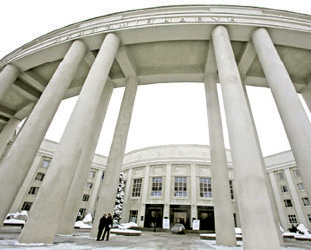
Culture discussed at National Academy of Sciences
The city clocks located near the National Academy of Sciences are inscribed, symbolically: ‘Culture Unites Us’. Headed by Culture Minister Boris Svetlov and the Chairman of the National Academy of Sciences’ Presidium, Vladimir Gusakov, the forum’s mood was sincere, with a clear desire to preserve the country’s legacy.
Professor Maria Bespalaya, from the Belarusian State University of Culture and Arts, stresses that globalisation obliges us to make greater efforts to nurture our national identity. She explains, “We’re sending our students on ethnographic expeditions and archaeological digs from their first year of study, so they can see with their own eyes and touch with their own hands the treasures indicating that we are Belarusians. Our spiritual legacy is the country’s golden fund, which cannot be devalued.”
Vyacheslav Danilovich, the Director of the National Academy of Sciences’ History Institute, has proposed compiling a Belarusian archaeological map, taking steps to save and study the cultural heritage of our most ancient cities — such as Logoisk, Kopyl, Slutsk and Zaslavl.
Many ideas are likely to find implementation in new state programmes, emphasises the Director of the National Academy of Sciences’ Centre of Belarusian Culture, Language and Literary Studies, Alexander Lokotko. He is keen that Belarusian culture should not lose its unique identity in our modern world.
Mainstream culture is known for its aspirational values, which can be aggressive. Monumental art, alongside stained glass and mosaics, is seen less frequently in modern facades, so that examples from the past are more valuable than ever. Of course, in order to encourage tourism, we need to ensure that historical sites are preserved and decorated carefully.
Mr. Lokotko hopes to build the Belarusian State Museum on the site of the former Great Patriotic War Museum building, on Nezavisimosti Avenue, surrounded by the Palace of the Republic, the Palace of Trade Unions and the Presidential Administration building. There, it would be in good company and would be likely to attract investment in coming years.
By Victor Andreev











